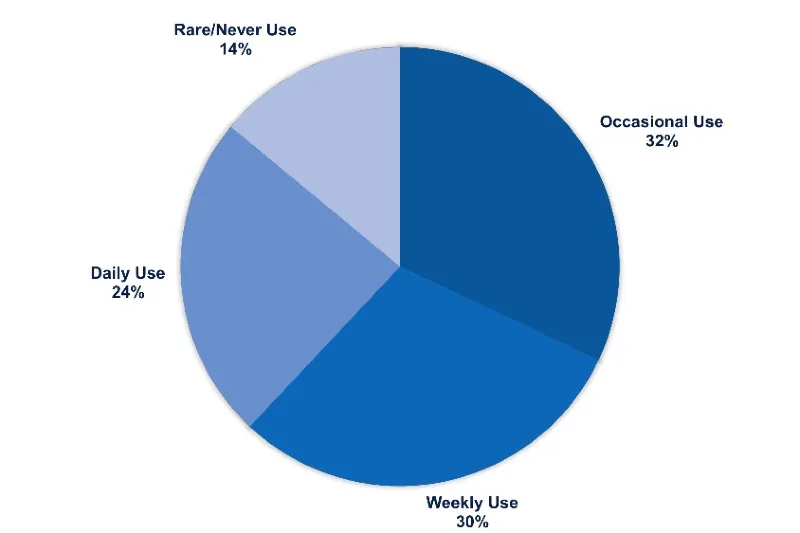AI in the Classroom: Hype or the New Homework Helper?
Artificial Intelligence (AI) is no longer a buzzword in education — it’s an everyday tool transforming how students learn and how educators teach. From automated feedback to personalized study support, AI is making learning smarter, faster, and more efficient.
Recent data underscores just how embedded AI has become in academic life — and where the gaps still exist:
- 92% of UK undergraduates used generative AI tools in 2025, up from 66% the year before (Higher Education Policy Institute).
- Only 25% of U.S. K–12 teachers believe AI tools do more good than harm in the classroom (Pew Research Center).
- 34% of educators say they frequently use AI in teaching, compared to 24% of students, revealing a reverse adoption gap (Pew Research Center).
Despite its growing prevalence, concerns around fairness, academic integrity, and digital equity persist. As AI continues to reshape the education landscape, it demands a balanced and ethical integration strategy that ensures its benefits are both meaningful and accessible.
The Global Surge: Why AI in Education Is Booming Right Now
From Chalkboards to Chatbots: The Numbers Behind the Shift
AI in the education market is rapidly scaling. According to Allied Market Research, it was valued at $2.5 billion in 2022, projected to reach $88.2 billion by 2032, with a staggering 43.3% compound annual growth rate (CAGR). Adoption among students is equally striking. A 2024 Digital Education Council survey revealed:
- 86% of students globally now use AI tools
- 24% use AI daily
- 54% use AI weekly
- Only 14% report rare or no usage

These numbers reflect not just popularity but normalization — AI has become part of the everyday academic toolkit.
Tools of Tomorrow: AI Study Helpers You Can’t Ignore
Personal Tutors in Your Pocket: Adaptive Learning Tools
Adaptive AI tools tailor content delivery based on each student’s pace, skill gaps, and mastery level. This eliminates the one-size-fits-all approach and allows students to review, accelerate, or revisit topics at will.
Notes, Summaries, and Study Packs: AI Content Generation
With increasing academic pressure, students are turning to AI-powered platforms that help summarize long texts, create flashcards, and organize complex material. This improves time efficiency and cognitive processing.
Chatbots That Teach: AI Explainers and Micro-Tutors
AI bots now simulate real-time academic conversations, guiding students through difficult subjects. These bots can answer questions, explain concepts, and even evaluate understanding in a natural, conversational way.
Grading and Feedback: AI as the Invisible TA
Teachers are using AI for automated grading, plagiarism detection, and formative feedback, helping them focus more on instructional design than administrative overhead.
Learning, Leveled Up: How AI Is Helping (With Data)
Sharper Minds, Faster Recall
A February 2024 research paper from IU International University found that students using AI teaching assistants experienced a 27% reduction in study time, thanks to adaptive tutoring, automated feedback, and personalized support across more than 40 online courses.
Another 2025 study showed that students who practiced writing with AI significantly outperformed peers on next-day writing assessments — despite reporting less effort. This highlights how AI study tools can enhance skill development.
Beyond Grades: AI for Inclusive and Accessible Learning
AI tools provide:
- Text-to-speech for visually impaired students
- Translation tools for non-native learners
- Customizable reading speeds and fonts for neurodiverse students
These features align with UNESCO’s digital inclusion goals and support academic equity at scale.
Beyond the Buzz: Ethical and Practical Pitfalls
Is Big Data Watching? Privacy and AI Ethics
AI in education brings privacy challenges. These systems collect data on learning behaviors, assessments, and even emotional cues. Compliance with GDPR, COPPA, and FERPA is necessary to protect students from misuse.
The Dependence Dilemma
Educators warn of overreliance. There’s concern that if students lean too heavily on automation, they may neglect critical thinking and problem-solving skills essential for long-term learning.
Mind the Gap: AI Accessibility Issues
A 2025 RAND Corporation report found that teachers in higher-poverty schools were less likely to use AI tools, citing lack of infrastructure and training. This highlights the importance of targeted policy and investment to close the digital divide.
Crystal Ball: What’s Next for AI and Student Learning?
From AI to XR: Immersive, Smart Learning
Future classrooms will merge AI with AR/VR technologies, creating interactive science labs, 3D history simulations, and virtual language exchanges — all personalized in real time.
Emotion AI and Mental Health Monitoring
Next-gen AI will detect signs of stress, disengagement, or anxiety based on facial expressions, keystroke rhythms, or tone of voice — enabling early intervention by educators and school counselors.
Human + AI: A Collaborative Learning Future
Educators won’t be replaced but augmented. With AI handling administrative and low-order tasks, teachers can invest more time in higher-order instruction and student well-being.
Final Thoughts: The Smart Student Era Has Arrived
AI is redefining the education ecosystem. From personalized tutoring to content summarization and predictive learning analytics, the shift toward smart, student-centered platforms is well underway.
However, this shift must be inclusive, ethical, and grounded in educational equity. Institutions, developers, and educators must collaborate to harness AI’s potential without compromising privacy, access, or cognitive development.
Students looking for reliable, peer-sourced academic materials can also benefit from platforms that complement AI tools — such as those offering curated study notes on Studocu, enabling smarter self-study alongside intelligent systems.
Frequently Asked Questions (FAQs)
Q1: Is AI replacing teachers in schools and universities?
No. AI is designed to assist, not replace, educators. It handles repetitive or administrative tasks, freeing teachers to focus on high-impact instruction and mentorship.
Q2: What are the biggest benefits of AI for students?
Improved time efficiency, personalized learning paths, instant feedback, and inclusive accessibility features for students with diverse needs.
Q3: Are AI learning tools safe for students’ data?
Most reputable platforms follow strict compliance frameworks like GDPR and COPPA. However, institutions must remain vigilant and transparent about data use.
Q4; Will AI tools become essential for academic success?
While not mandatory, AI tools are becoming integral to modern learning. Their effectiveness in improving comprehension and retention makes them valuable assets.


